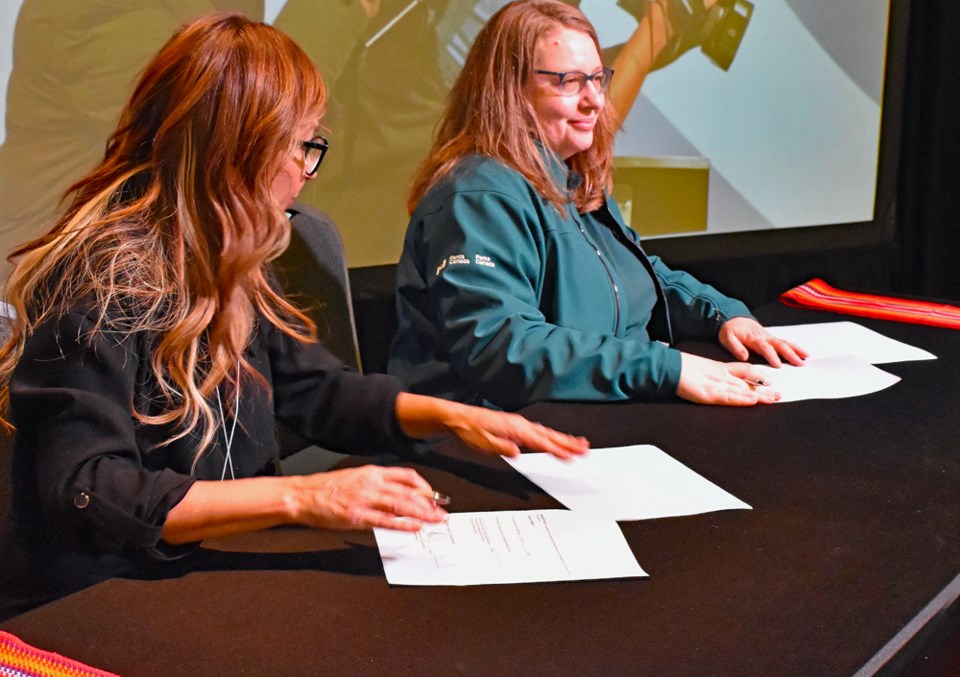SASKATOON — A bison herd will be roaming the grasslands of Batoche next year after the Métis Nation-Saskatchewan and Parks Canada signed a memorandum of understanding on Friday, Nov. 18, marking another historic day for Métis citizens.
MN-S Vice President Michelle LeClair and Parks Canada Saskatchewan South Field Unit Acting Superintendent Genevieve Jones signed the MOU during the MN-S fall 2022 Legislative Assembly at Prairieland Park.
The MOU signing formalizes the transfer of an expected 30 head of bison from the Grasslands National Park in Southern Saskatchewan, where they managed to increase the herd’s population from 400 to 500.
The bison originally came from Elk Island National Park in Alberta, 35 kilometres east of Edmonton. The bison has also returned to its traditional lands in Wanuskewin Heritage Park, where several calves were born.
This is the second time that MN-S and Parks Canada partnered on a project following the federal government's transfer of 690 hectares of land in July of this year. The document was signed during the 50th Back to Batoche festival.
LeClair thanked Parks Canada for their continued working relationship with MN-S with the latest collaboration helping the plains bison return to roam freely in Batoche, where they can soon develop their herd that can be distributed to other Métis communities in the province.
“The long-term strategy is to develop bison herds on each side of the Batoche lands, and we’re hoping that the herd size will reach 150. There are also economic opportunities through the handling and processing of the bison,” said LeClair.
“It provides food security for elders and families and cultural celebrations like our Back to Batoche event. Métis communities will be provided with calves to start their herds. I’m proud to facilitate this MOU.”
She added that she’s excited to formulate a plan to have the bison return to Métis lands as it also represents a cultural significance between the said animal and Métis communities in Saskatchewan.
“Bison represents a deep cultural connection to the Métis. It represents our values of living in harmony, perseverance and coexistence. For us, the value is that going back to some of the traditional ways and food security is the big one,” said LeClair.
“Being able to process the bison and all those kinds of things become part of that cultural value. As stewards of the land, returning [bison] species to the homeland of the Métis will assist the MN-S in restoring healthy and natural ecosystems.”
LeClair said the MOU signing is the first step of a two-phase process in having the bison herd moved to Batoche from Grasslands National Park and would lay the groundwork for a comprehensive strategy where Métis and the bison will once again coexist.
The first phase of transferring the herd is expected in the winter of 2023, with MN-S securing funding from Agriculture [and Agri Food] Canada to put up a proper fence and other things that would be needed once the bison returned to Batoche.
Jones said the bison were reintroduced to Grasslands National Park in 2005 for the first time after 120 years, where they translocate out of the park to maintain the herd’s health and keep their target numbers of 500 to 650 heads.
“We have a long history of collaboration with [MN-S] and share a common interest in protecting natural and cultural heritage at Batoche National Historic site. We’ll look at the number of bison we need to translocate,” Jones said.
“We [Parks Canada] were contacted by [MN-S] regarding their interest in bison from Grasslands National Park. That’s how the discussion started. We accept requests from groups for bison translocation and assess these with the priority of conservation and Indigenous partners.”




